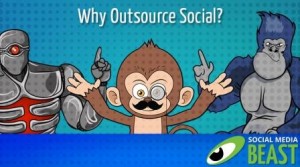There are different ways of defining success on social media. A large audience for example, is the one but not the only indicator of a successful brand. Other metrics of success could be traffic or leads generation, engagement, brand awareness or even sales.
However, a closer look at some of the top brands on social media reveals that they share some common traits. Let’s take a look at some of those:
They have a strategy
The thing is, every single action you perform on social media, every tweet you post, every comment you reply to, is or should be, part of your overall presence on social media and yet another way to market your brand. And really successful brands on social media have a plan.
So how can you build your own? A social media marketing plan is a summary of everything you plan to do and aim to achieve for your business using social media. The more specific your plan is, the more effective you’ll be implementing it.
When putting together your plan, keep in mind that you’ll basically use this as a guide for all your future social media marketing actions. So it needs to be clear and concise, with well-defined goals and KPIs.

They have a distinct voice
Defining your brand’s voice and tone is particularly important when more than one people are involved in managing your social media presence. But even if this is not the case for many small and medium businesses out there, having a clear voice and tone for your brand can help you craft better copy that resonates well with your target audience.
What is the different between tone and voice, you ask. Kevan Gilbert on Gather Content defines “voice” as a personality trait. Joanna Wiebe from Copy Hackers describes tone of voice in a great way:
Your message is what you try to communicate. Your tone of voice is how you communicate it. Tone takes a statement and either breathes life into it…or sucks the life out of it.
If you’re looking for some inspiration on where to start with defining your brand’s voice and tone, check out Mailchimp’s wonderful guide here, or go through Distilled’s in-depth guide to tone of voice and these examples right below from General Electric and Taco Bell.
Caution: Will cause drooling. pic.twitter.com/dejsAzth1e
— Taco Bell (@tacobell) January 21, 2016
They deliver quality content
Great content is obviously content that is shareable. A recent study by researchers at Cornell university has found that people share a tweet when it adds information, it is formatted as a news headline and it agrees with the community’s ways of expression.
But what is it that makes content irresistible and impossible to ignore? Three elements: value, relevance, consistency.
The three elements of amazing content: value, relevance, consistency
Click To Tweet
1.Value
The first question your audience will ask themselves before they go on and share your content is “what’s in it for me?”
In other words the greater your value proposition the more likely your content is to get shared. Valuable content is content that is useful, informational, educational and of course entertaining.
Creating value for your audience requires knowing who your audience is, what do they like and what they would find useful.
Surveys, social media monitoring and tools like Google Analytics will provide you with insights on who is your audience, where they’re coming from and what is their online behavior. This will help you decide which content is valuable to them and try to cater to their needs and resolve their problems.
2. Relevance
Again, this requires understanding the basic characteristics of your audience and who they are. This way, you can figure out what type of content would be relevant to them.
It is important to keep in mind that the element of relevance is twofold. On the one hand it refers to content that is relevant to your audience and on the other to hand to content that is relevant to your brand’s identity.
Value and relevance might be hard to achieve but once you do, you will start attracting quality audience that will help your business grow to the right direction.
3. Consistency
Consistency is the third element of what constitutes good content. Content consistency means staying true to what you and your brand stands for, being consistent about how your content is presented, maintaining your tone and voice and posting your content on a frequent basis.
Being consistent about the content you share on social media will help you build your brand’s credibility and develop trust with your audience. This way, people will know what your content is about and will keep coming back for more.
Check out some examples of outstanding content from Airbnb and Oreo:
They engage with their audience in different ways
According to the New York Times’ Customer Insights Group, there are five main reasons why people share content online, which CoSchedule summarized in a helpful infographic.
- To add value: 94% consider the value and utility that the information they share will have for their audience.
- To define themselves: 68% share to define themselves both to others and to themselves.
- To grow and nourish relationships: 73% share content online to help them connect with others who share their interests.
- Self fulfilment: 69% share information that makes them feel more involved with the world.
- To get the word out about causes they believe in: 84% share information as a way to support causes (or brands) they care about.
With this in mind, it is important to diversify your content and choose different formats of delivering your message other than simple text and links across platforms. Images, videos, live-streaming, GIFs or contests as well as using Twitter polls that encourage further interaction with your audience, are content elements that are likely to increase your engagement, generate leads and maintain the interest of your followers.
They are there for their communities
Successful brands realize that social media is not just a one-way communication. On the contrary, they are conversational and interact with their audience. Spending as much as a few minutes a day asking questions, replying to comments, engaging with your community and sharing your community’s content can really make a difference.
Twitter chats for example, are a great way to engage with your community on Twitter, build authority for your brand and expand your reach. They provide you with the chance to be useful and relevant, offer your help and communicate your brand’s voice and identity.
Social Media is definitely not email which means that for brands in particular, it is very important to be quick and responsive when users reach out to you on the platform. 35% of people turn to social media seeking customer support and these people expect a fast response.
More specifically, 42% of the consumers that have filed complaints on social media, expect a response within an hour. Even if you’re not able to resolve an issue right away, a simple acknowledgement that you have received the message and you’re working on it, is already a good step.
Seamless is one of the brands that provide quick customer service on Twitter and a good example of fast, helpful responses.
@peysaywhat We’re really sorry you haven’t received your order! Please follow and DM us the order number. We can reach out for an update!
— Seamless (@Seamless) February 9, 2016
What is perhaps even more important than quick response however, is perhaps addressing negative feedback.
Negative comments can in fact be an opportunity to show your commitment to your customers and provide your audience with the best service you can.
Ignoring a negative comment on social media is perceived as indifference towards your audience and simply sends out the wrong message. Let alone that your lack of attention, can push things out of control very quickly.
Instead, you should opt for responsiveness in a constructive way. A great example of a brand that actively engages with customers that complain on social media is KLM.
@EuniceNyandat Hello Eunice, we noticed your tweet. Could you please elaborate and share us your story with us? We’re listening!
— Royal Dutch Airlines (@KLM) November 30, 2014
We’d love to know what do you struggle with the most when it comes to building a social media presence for your brand. Let us know in the comments right below!
Digital & Social Articles on Business 2 Community(90)






